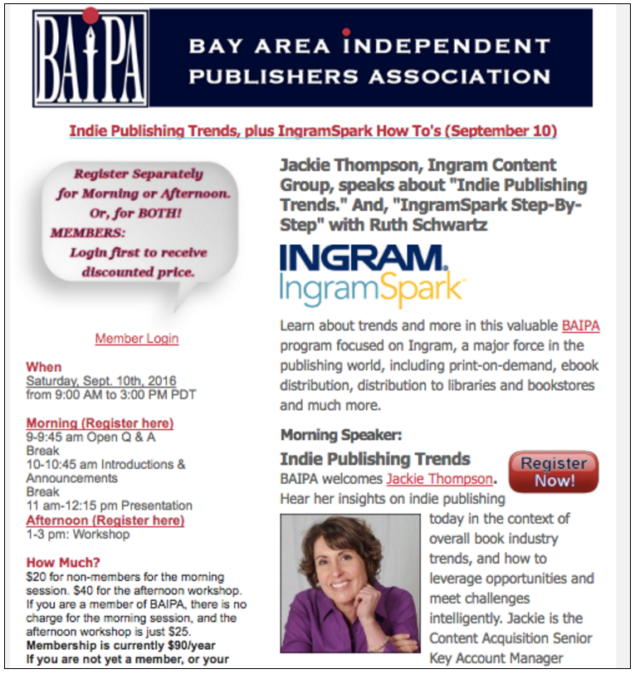Here are some key takeaways from the September 10, 2016 BAIPA meeting, which featured Jackie Thompson of Ingram Content Group speaking about Ingram’s digital distribution and print-on-demand services.
1. Learn about the book industry
- Think about what you’re writing, what you’re going to do next. Peek behind the veil. Learn what publishers are thinking about.
- There’s lots of data out there: First, off, you’re competing in a flat growth industry. Only half of Americans have read a book in the past year.
Publishers Weekly is an industry magazine that’s online. They talk about what booksellers are doing. Publishers Lunch is an email that we read every day.
Here’s some data:
- Industry sales down .6% in 2015
- Strongest gains in children’s/young adult (+17%) and adult nonfiction (+10.9%)
- Adult fiction up by 1.1.% (boosted by adult coloring books)
- Audiobooks up up 37.6%
- Trade e-book sales down 11.3%
- Formats: Hardcover up 8.3%, trade paperback up 2.7%
- Sales through brick and mortar and online retailers up in 2015
- Online sales accounting for 32.8%, physical stores 24.9% (Also Target, airports…)Average fiction price: $17.99
- Juvenile nonfiction: $12.99
- Comics and Graphic Novels $17.99

2. Think about what your competition is.
There are always comparables. Find books like yours. Find out what those authors are doing. Look for authors who sell more than you do. Set your price accordingly.
- Look at their author page. Look at twitter. Dig in. What is she doing on her website? What happens when I google his name? Does she publish an email newsletter?
- You can also use that comp on your website. If you loved All the King’s Men, you’ll love Bones in the Wash. (She didn’t say that, but I used it as an example in my notes.) Buyers look at comps.
- Buyers want to know how you’re going to succeed so you can say, I’ve got an author tour. I’ve got thousands of followers. That’s why my book is going to sell.
3. Keep one person in mind as a reader to help you focus your marketing.
4. If you set up print-on-demand with Ingram, your book can be gotten anywhere — bookstores, libraries. But you need to create the demand.
5. More industry data
- Average American read 12 books last year. Men 9, women 14
- College grads read an average of 17 books
- Digital readership is flat.
- Six percent of Americans read ebooks. Twenty-eight percent read an ebook last year.
- Smart phone reading up from 5% to 13%
- Most common trim sizes: 6 x 9 (29%) 5.5 x 8.5 (22%)
6. Here’s how books are distributed
- Online
- Re-sellers (bookstores)
- American Booksellers Assn includes (2200 stores)
- Chains (Barnes and Noble has 640 stores)
- Libraries
- Mass merchandisers (Target, Walmart, Costco)
- Gift stores
Ingram reaches 39,000+ resellers.
The great thing about joining Ingram Spark is it’s the only print-on-demand vendor that reaches this broad a market
7. To get “full distribution,” you need a track record:
- Good number of proven already released backlist books
- New releases every season
- Adhere to regular schedule
8. The optimal file format for Ingram print-on-demand is a pdf created from InDesign.
9. It’s really critical you own your ISBN. You cannot use the free CreateSpace ISBN. If you have your own ISBN, then the book on Ingram and the book on CreateSpace can and should have the same ISBN.
10. Get your metadata published in advance of your book. Even if you have three more chapters to write. You can guess at a price. As long as it doesn’t change by 20%.
You can do pre-orders. Post a tentative table of contents. This is how you get momentum in advance.
11. Ingram will not market your book to stores (unless you’re a bestseller), but makes it available. Someone can walk into a bookstore and order your book.
12. Do on-demand books show up differently in online catalog? They used to. But now it’s masked. Booksellers can’t tell if it’s POD only. Randomize the number available.
13. Invest in professional editing, design, and marketing
Before Jackie’s presentation, there was a Q&A session, as there is every month. Here are some questions and answers.
Anyone have experience with movie trailer for book?
- I used Camtasia to record camera track, powerpoint track, and voice. Layering process, then use video compression that creates MP4 that you can upload to YouTube.
- Most trailers have only a couple hundred views on YouTube. Even popular authors don’t have many views. Often they’re not entertaining enough.
- I did an iMovie version, used as ad on Instagram. It’s 40 seconds. Two minutes is an eternity on the web.
Does it make sense to do print-on-demand in color?
- Much more expensive in color. Can be five times as much. However, you can publish in both black-and-white as well as color.
- It’s not just an issue with the cost of printing, but the challenge of distribution.
Are they two different ISBNs if one is color and one is black and white?
- Yes.
Note: We’d like to continue posting a takeaways summary every month. I will not be there at the October meeting. Would be great if someone could pick up the baton. I’ll help. Contact me at [email protected].
Note: If you were at the September meeting and you didn’t get a chance to fill out a feedback form, we would love it if you did so below. Thank you.